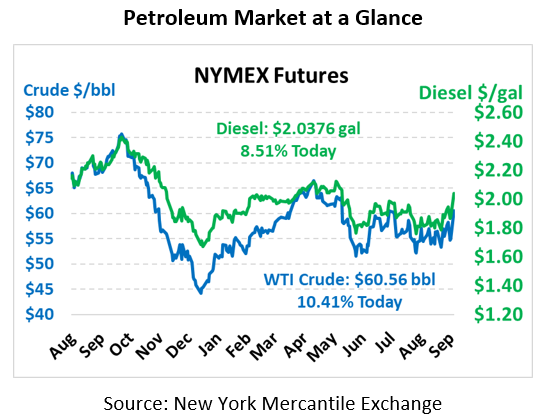
Largest Price Spike in Crude History, US “Locked and Loaded”
Oil prices rose by the largest amount in history this weekend after a shocking attack on Saudi Arabian oil production. Across the board, the energy complex is trading significantly higher amid the shocking outage. WTI crude oil is trading at $60.56 after gaining $5.71 (+10.4%) in the wake of the attack. Brent WTI crude, after trading as much as $11/bbl higher, is currently up $6.50.
Fuel prices are seeing radical price leaps as well, though trailing a bit behind crude. Diesel prices are trading at $2.0376 this morning after gaining 16 cents (+8.5%) since Friday. Gasoline prices are trading at $1.7018, up 14.9 cents (+9.6%).
What Happened?
This weekend, Saudi Arabia shut down fully half of its oil production following drone strikes on facilities in Abqaiq and Khurais. The attacks caused 5.7 million barrels per day (MMbpd) of production to go offline – half of Saudi Arabia’s output and 5% of global crude oil production.
Who Did It?
Yemeni Houthi rebels, generally believed to be supported by Iran, took credit for the attack and claimed they launched ten drones at the locations. Some have pointed out that the attack represents a huge increase in their capabilities that would be unlikely without outside support. US Defense Secretary Pompeo has claimed there’s no evidence the attack came from Yemen at all, pinning the attack directly on Iran. So far, no official report has been released from the US or Saudi government declaring who is responsible. President Trump tweeted the US has reasons to believe we know the culprits, though America will wait on Saudi Arabia’s assessment.
How Are Markets Reacting?
Oil prices rose as much as 20% in overnight trading following the news, though prices have moderated slightly. Saudi Arabia noted plans to use existing inventories to maintain exports for key customers, so markets won’t feel the full brunt of the major outage. Europe’s Brent crude contract has seen larger affects than America’s WTI contract, given their proximity and reliance upon Saudi Arabia. Fortunately, global inventories have been high, so the world should have plenty of excess crude while Saudi Arabia repairs its facilities.
How Long Will It Take to Fix?
So far, the 5.7 MMbpd lost in the outage remain offline. Some media sources have suggested that up to 2 MMbpd could be returned to production relatively quickly, but recent comments from Saudi officials note repairs “will take weeks, not days.” We’ll learn more today and tomorrow about the long-term implications of the strike. The duration of repairs is the most important factor for oil prices; a prolonged outage could keep oil prices elevated for weeks or months, while rapid repairs might help contain prices more quickly.
How Does This Affect Our Fuel?
Saudi Arabian imports make up a small share of American crude demand, given their geographic distance from us. President Trump has authorized using oil from the Strategic Petroleum Reserve to offset the oil price impact in the US. Areas of the country more reliant on imported fuel, such as the Northeast, may see large price hikes than the West Coast, which is farther removed from the outage. The extreme fuel price volatility may have implications in the near-term, potentially affecting local supply markets.
What Comes Next?
Unfortunately, this is the most challenging question to answer. Saudi Arabian oil fields have been the target of Houthi attacks for years, though never has an attack successfully dislodged so much production at once. President Trump has tweeted that the US is “locked and loaded”, ready to respond once the Saudis concur with America’s assessment of the perpetrators. There are many ways this could escalate to a larger conflict, including secondary attacks by the Houthis, continued aggression from Iran in the Strait of Hormuz, or a strong and aggressive US action against Iran.
FUELSNews will keep you apprised as the situation evolves, including emergency updates as necessary. Stay tuned.
This article is part of Alerts
Tagged:
MARKET CONDITION REPORT - DISCLAIMER
The information contained herein is derived from sources believed to be reliable; however, this information is not guaranteed as to its accuracy or completeness. Furthermore, no responsibility is assumed for use of this material and no express or implied warranties or guarantees are made. This material and any view or comment expressed herein are provided for informational purposes only and should not be construed in any way as an inducement or recommendation to buy or sell products, commodity futures or options contracts.






